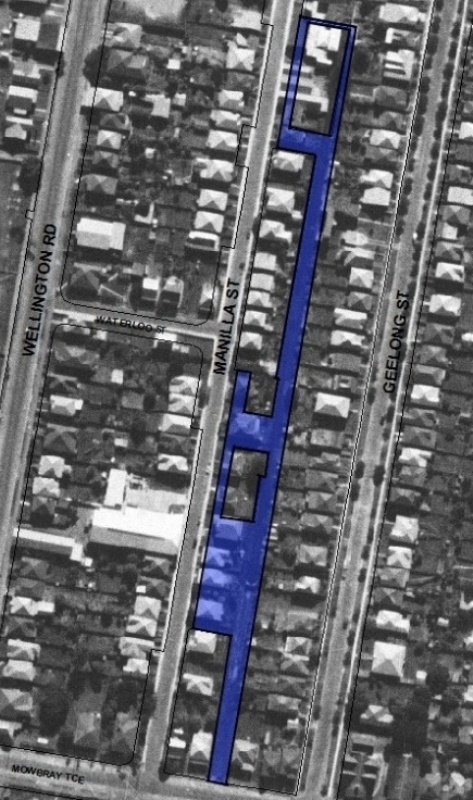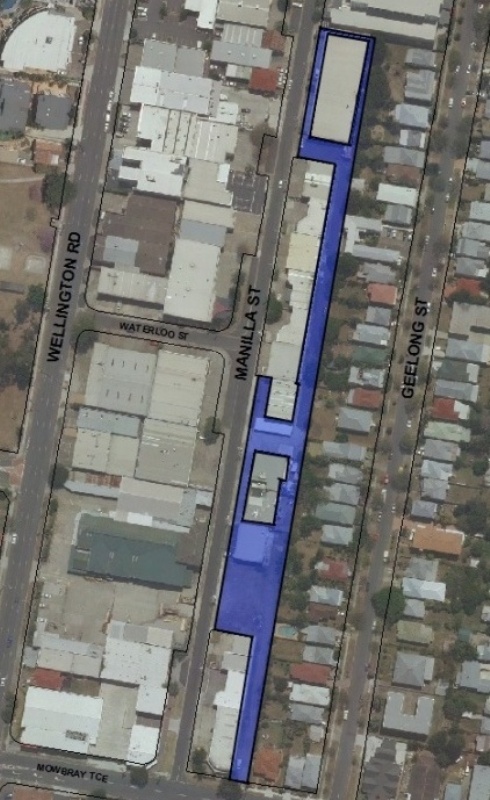Addresses
- At Manilla Street, East brisbane, Queensland 4169;
- At 13 Manilla Street, East brisbane, Queensland 4169;
- At 19 Manilla Street, East brisbane, Queensland 4169;
- At 25 Manilla Street, East brisbane, Queensland 4169;
- At 31 Manilla Street, East brisbane, Queensland 4169;
- At 65 Manilla Street, East brisbane, Queensland 4169
Type of place
Process (other)
Period
Victorian 1860-1890
Style
Warehouse
Addresses
- At Manilla Street, East brisbane, Queensland 4169;
- At 13 Manilla Street, East brisbane, Queensland 4169;
- At 19 Manilla Street, East brisbane, Queensland 4169;
- At 25 Manilla Street, East brisbane, Queensland 4169;
- At 31 Manilla Street, East brisbane, Queensland 4169;
- At 65 Manilla Street, East brisbane, Queensland 4169
Type of place
Process (other)
Period
Victorian 1860-1890
Style
Warehouse
Forsyth’s Rope Works was established at East Brisbane in the mid-1870s, and the Rope Walk associated with the Works remains the sole surviving evidence of this important industry. In the 19th century Forsyth’s was the only rope manufacturer in Queensland and one of only a few in the Australian colonies. Rope making was an important industry, and Forsyth’s Rope Works at East Brisbane made a significant contribution to the development of agriculture, industry and maritime trade in Queensland.
Lot plan
Geolocation
-27.481591 153.042176
Key dates
Local Heritage Place Since —
Date of Citation —
Criterion for listing
(A) Historical; (B) Rarity; (C) Scientific; (F) Technical; (H) Historical associationInteractive mapping
Lot plan
Geolocation
-27.481591 153.042176
Key dates
Local Heritage Place Since —
Date of Citation —
Criterion for listing
(A) Historical; (B) Rarity; (C) Scientific; (F) Technical; (H) Historical associationInteractive mapping
History
The Rope Walk was formerly part of Forsyth’s Rope Works, established in 1876 at Lytton Road (then known as Cleveland Rd) East Brisbane. The Rope Works was one of Queensland’s earliest viable secondary industries, established by A Forsyth & Co of the Sydney Rope Works.
In 1874 Archibald Forsyth, a successful Sydney rope manufacturer, purchased land from Joseph Darragh for £600 in a newly established suburb, known then as ‘Mowbraytown’, later to become East Brisbane. Within two years, a purpose built factory, originally known as the ‘Kangaroo Point Rope Works’ was operating on the site under the management of Henry A Maynard. In connection with the works, the company erected a wharf and store about half a mile down the Brisbane River, which was used for landing and storing imported raw materials, comprised mainly of hemp from Manilla and flax from New Zealand. The company’s symbol was a kookaburra holding a piece of rope supposedly inspired by the family of kookaburras residing in nearby Mowbray Park.
In October 1876, Archibald Forsyth joined Thomas McIlwraith in a deputation to the Queensland Treasury to criticise the levying of a heavy duty import duty on Manilla hemp by Queensland Customs authorities. The issue was resolved in Forsyth’s favour and rope-making became one of the first successful secondary industries to be established in Queensland. The nearby parallel street, originally named Factory Street on the Ropeworks Estate Map of 1884, was changed to Manilla Street by 1890, in reference to the hemp imported for rope manufacturing from the Philippines.
The Rope Works consisted of a large brick building and a ‘ropewalk’. The form of the ropewalk reflects the process of ropemaking used in Australia for over a century. The first process involved making the strands by securing the base yarns to hooks on the traveller (cart) which turned whilst the traveller progressed along the rails for the length of the ropewalk. A creel (or frame) bunched the yards together to form the strand and brackets supported the length of the strand as it was twisted. The Manilla Street ropewalk was 1100 feet long and 15 feet wide. It consisted of a roofed timber battened structure covering two metal tracks along which a small ‘traveller’ ran to stretch the larger ropes.
By the 1880’s Forsyth was known for the supply of high-quality rope and for the supply of harvesting twines to inland country areas. Following the depression years of 1891-93, the firm was privatised and known as A Forsyth & Co Limited of the Australian Rope Works, Waterloo. Forsyth and his relatives held the 65,000 shares. During the 1890’s, both the Brisbane and Sydney plants were extended twice and the plant was modernised. John Forsyth, Archibald’s nephew, travelled overseas during this time to investigate new machinery. By 1908 the Brisbane works were producing over two hundred tons of rope annually and was an important source of employment in the local area. Forsyth’s Ropeworks provided continuous employment over a number of decades and successive generations of workers were employed at the factory. This continuity was considered an important factor in the rise of the firm as one of the largest and most successful rope makers in Australia.
Frederick A Thorpe, Archibald’s son-in-law was appointed Manager following John Forsyth’s death in 1915 and bought more land for future extensions in Brisbane and Sydney. World War One created great demand for the firm’s products, and despite droughts in the early part of the twentieth century in Queensland affecting the demand for harvest twine, the factory survived and in 1925 a new ropemaking machine was installed. The constant modernisation of the plant helped the company survive the depression years of 1929 and the early 1930’s.
In 1933 when fire destroyed the buildings and large stocks of raw material, the employees took a cut in wages and helped in the rebuilding of the plant. Only the external walls survived and subsequent reconstruction by Baxter and Hargreaves included strengthening these with concrete columns. The cost of reconstruction was £3,540. The company recovered and by 1938 the Brisbane factory was again working full time.
During the early part of World War Two the Commonwealth government instituted controls over a number of articles, including sisal, manila, raw jute and flax and goods manufactured from jute, and the factories ran to full capacity, filling many of the defence orders from Australian, British and United States forces. A program of modernisation followed the end of the war and specialised spinners and ropemaking machines were introduced into both the Sydney and Brisbane factories. In Brisbane, extensions were built to house the plant, and production considerably increased as a result. The company was now producing woollen hair and felt, and a fall in the demand from the shipping industry was offset by an increase in the consumption of harvesting twine.
The company continued operation as Forsyth’s until the late 1960’s when it was sold and the name changed to Miller’s. In 1978 it was renamed Kinnear’s and continued to manufacture binder twine, as well as a large range of rope until it ceased operation in 1997. Most of the buildings previously associated with the rope works have now been demolished, but the extreme length of the rope walk itself is still in evidence. The operation of the rope walk remains evident in the long narrow subdivision between and parallel to Manilla and Geelong Streets, East Brisbane.
Description
Forsyth’s Rope Walk (former) is a long narrow space, oriented north-south, located in the centre of the block of land bounded by Lytton Road, Mowbray Terrace, Manilla Street and Geelong Street, East Brisbane. The adjoining Geelong Street allotments are residential blocks, and the allotments on the western and southern sides of the walk contain commercial and light industrial buildings fronting Manilla Street, built to the rope walk alignment. The area north of the walk, formerly the site of the main rope walks buildings, which fronted Lytton Road, has been developed.
At the northern end of the space a late twentieth century commercial/industrial building intrudes onto the former ropewalk. This building is not considered to be of cultural heritage significance and is not included in the heritage curtilage. The remainder of the walk survives as an uncovered lane, with a surface of bitumen or concrete. There is no above ground evidence of the former tramway via which the rope strands were hauled along the traveller, but there may be archaeological evidence of this.
Statement of significance
Relevant assessment criteria
This is a place of local heritage significance and meets one or more of the local heritage criteria under the Heritage planning scheme policy of the Brisbane City Plan 2014. It is significant because:
References
-
Brisbane City Council Building Registers
-
Brisbane City Council WebBASX maps – cadastre, 1946 aerial, 2001 aerial, 2005 aerial
-
MacMillan, D.S, 1965, One Hundred Years of Rope-making:1865-1965, Sydney
-
Estate Sales Maps, 1884, 1890
-
Environmental Protection Agency, File No.601615, 2004
Citation prepared by — Brisbane City Council (page revised August 2023)

